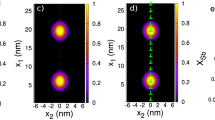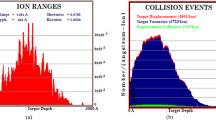Abstract
The relaxation of a silicon defect subsystem modified by the implantation of high-energy heavy ions was studied by varying the electrical properties of irradiated Si crystal annealed at a temperature of 450°C. It is shown that quenched-in acceptors are introduced into Si crystals as a result of irradiation with comparatively low doses of Bi ions and subsequent relatively short annealing (no longer than 5 h); the distribution of these quenched-in acceptors has two peaks located at a depth of about 10 µm and at a depth corresponding approximately to the ions’ projected range (43.5 µm). The peaks in the distribution of quenched-in acceptors correspond to the regions enriched with vacancy-containing defects. As the heat-treatment duration increases, the acceptor centers are transformed into donor centers with the centers’ spatial distribution remaining intact. Simultaneously, an almost uniform introduction of quenched-in donors occurs in the entire crystal beyond the depth corresponding to the projected range of ions.
Similar content being viewed by others
References
R. Kögler, A. Peeva, P. Werner, et al., Nucl. Instrum. Methods Phys. Res. B 175–177, 340 (2001).
R. Kalyanaraman, T. E. Haynes, M. Yoon, et al., Nucl. Instrum. Methods Phys. Res. B 175–177, 182 (2001).
A. Agarwal, K. Christensen, D. Venables, et al., Appl. Phys. Lett. 69, 3899 (1996).
R. A. Brown, O. Kononchuk, G. A. Rozgonyi, et al., J. Appl. Phys. 84, 2459 (1998).
A. Borgezi, B. Pivac, A. Sassella, and A. Stella, J. Appl. Phys. 77, 4169 (1995).
V. F. Stas’, I. V. Antonova, E. P. Neustroev, et al., Fiz. Tekh. Poluprovodn. (St. Petersburg) 34, 162 (2000) [Semiconductors 34, 155 (2000)].
A. Dunlop, G. Jaskierowicz, and S. Della-Negra, Nucl. Instrum. Methods Phys. Res. B 146, 302 (1998).
A. R. Chelyadinskii, V. S. Varichenko, and A. M. Zaitsev, Fiz. Tverd. Tela (St. Petersburg) 40, 1627 (1998) [Phys. Solid State 40, 1478 (1998)].
E. P. Neustroev, I. V. Antonova, V. P. Popov, et al., Nucl. Instrum. Methods Phys. Res. B 171, 443 (2000).
I. V. Antonova, E. P. Neustroev, V. P. Popov, and V. F. Stas’, Perspekt. Mater. 1, 43 (2001).
I. V. Antonova, E. P. Neustroev, V. P. Popov, et al., Physica B (Amsterdam) 270(1–2), 1 (1999).
V. V. Voronkov, G. I. Voronkova, A. V. Batunina, et al., Fiz. Tverd. Tela (St. Petersburg) 42, 1969 (2000) [Phys. Solid State 42, 2022 (2000)].
Author information
Authors and Affiliations
Additional information
__________
Translated from Fizika i Tekhnika Poluprovodnikov, Vol. 37, No. 5, 2003, pp. 565–569.
Original Russian Text Copyright © 2003 by Smagulova, Antonova, Neustroev, Skuratov.
Rights and permissions
About this article
Cite this article
Smagulova, S.A., Antonova, I.V., Neustroev, E.P. et al. Relaxation of a defect subsystem in silicon irradiated with high-energy heavy ions. Semiconductors 37, 546–550 (2003). https://doi.org/10.1134/1.1575358
Received:
Accepted:
Issue Date:
DOI: https://doi.org/10.1134/1.1575358




